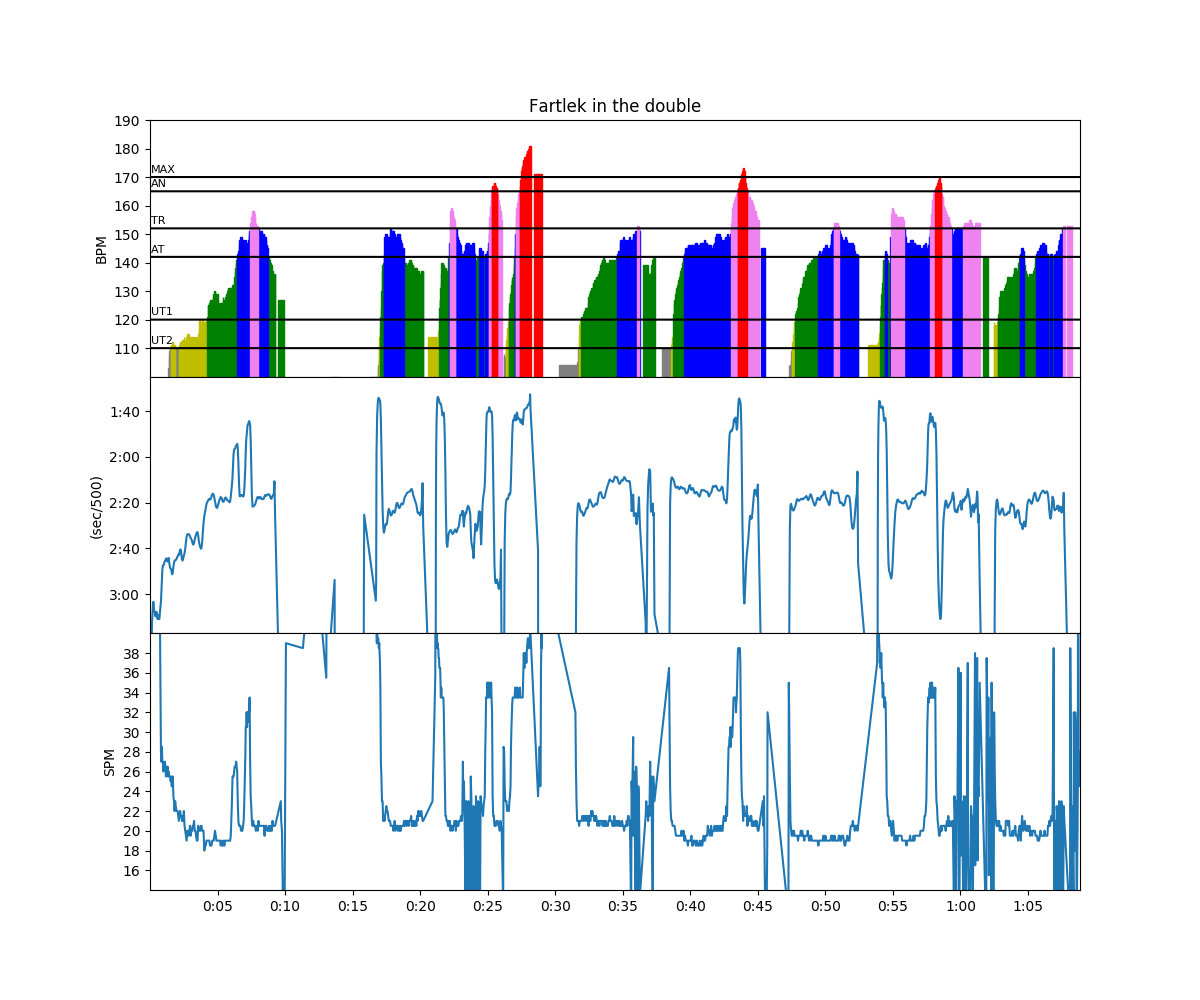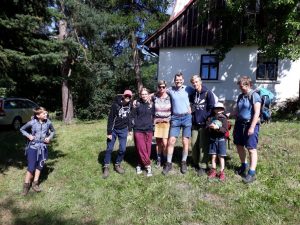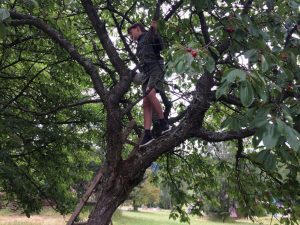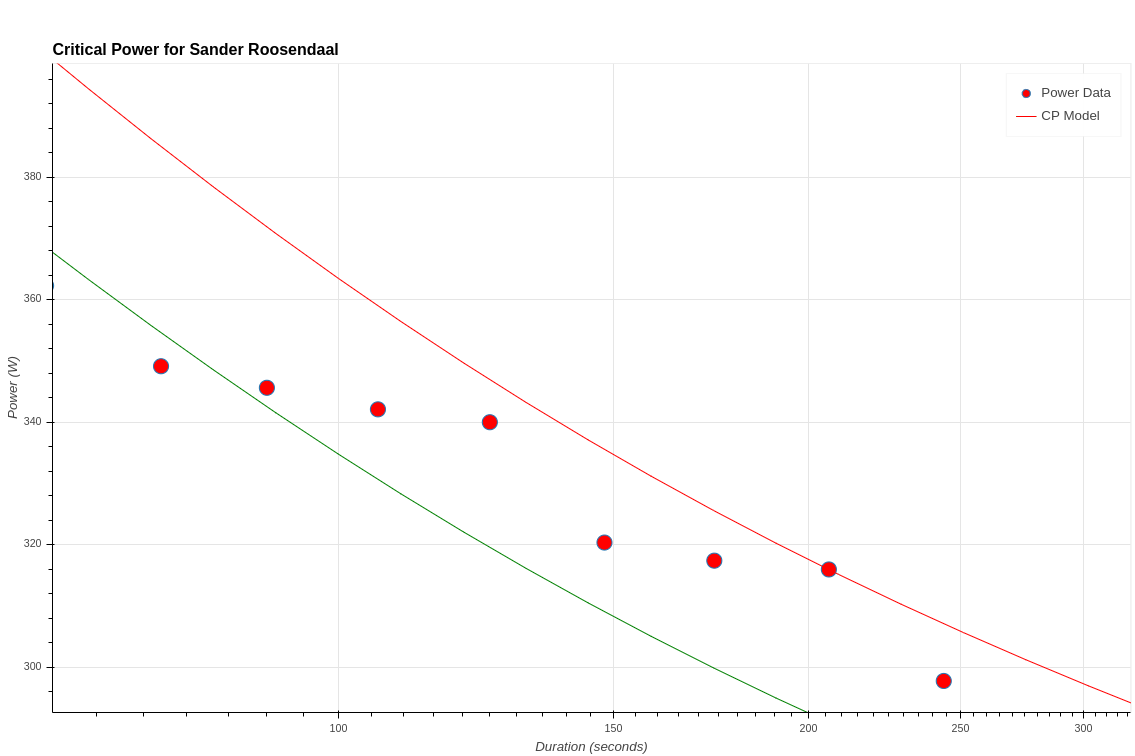On Sunday, June 30th, Kazi and I rowed a fun fartlek style workout in the double.

Then, on Monday, we drove off to Romana’s family cottage in the Giant Mountains, Czech Republic, where we were joined by my sister, her two sons, and a close friend.

And that was the start of a near two week intermezzo of unstructured cross training, which consisted mainly of hiking, but also involved sawing, hauling logs, building camp fires, and other pleasant mountain activities.
We did a five day trek through the mountains, doing an average of 6 hours of hiking a day.
 Some nice mountain huts. Some unexpected encounters:
Some nice mountain huts. Some unexpected encounters:

And of course we had to cherry-pick:

Thursday was travel day and on Friday, I had my first outing in the single after this good break.

The weather was funny. It was clouded and there were intense rain showers, which lasted about 10 to 20 seconds. I got totally wet, but it wasn’t unpleasant, because the air temperature was still around 22 degrees.
The workout was just paddling and a few pieces to establish a baseline, going into the last 8 weeks of preparing for the World Rowing Masters Regatta. After a few warming up sequences and practice starts, I did the following pieces:
- Trying to hold 330W for as long as possible. I basically broke down at the first bite of lactate pain.
- A four minute piece, evenly paced, maximum Watts
- A full out one minute piece
The first piece is slightly above what I think I can hold for a 1k race.
This was rowed into a slight head / cross wind.
Workout Details
#-|SDist|-Split-|-SPace-|-Pwr-|SPM-|AvgHR|MaxHR|DPS-
00|00588|02:16.2|01:55.7|335.7|31.7|000.0|0.0|08.2
I originally wanted to continue pushing until the average power (on the NK SpeedCoach) showed 5W below the target, but somehow, after the vacation, I wasn’t prepared for the lactate rush and I just stopped rowing. Well, 588 meters. It’s a baseline, and I think pushing this out to something closer to 1000 meters is realistic.
I did a 3000 meter paddle to recover, then started a 4 minute piece. The goal of this one was to row it flat pace (power) but max out over four minutes. I was careful this time and chose 300W as the target.
Workout Details
#-|SDist|-Split-|-SPace-|-Pwr-|SPM-|AvgHR|MaxHR|DPS-
01|00981|03:50.6|01:57.6|298.9|29.5|000.0|0.0|08.6
Again, this was done from a race start.
I was surprised by how low I could rate but decided not to bother about stroke rate. It turns out I was at 600 J Work per Stroke, which is above what I am aiming for. Need to work on lightening up.
The third piece was a full out minute, from a standing start, which I did after a 2.5k paddle.
Workout Details
#-|SDist|-Split-|-SPace-|-Pwr-|SPM-|AvgHR|MaxHR|DPS-
00|00254|00:57.0|01:52.4|395.7|35.7|000.0|0.0|07.5
I have no heart rate data, because I forgot to pack my heart rate band. So why am I doing all this? Because, using the Critical Power plot functionality of rowsandall.com, I can use those three pieces to get a feeling for where I stand in terms of 1k fitness:

The chart takes data from yesterday’s pieces, plus a few longer pieces that I did in the fall and this spring. It doesn’t contain sprint data from the 2018 season.
Here’s a close-up:
 This section of the CP curve starts at one minute and ends at five minutes. I expect the sprint races to take between 3:40 minutes and 4 minutes, depending on the weather conditions. The green curve is a conservative estimate and gives guidance for training pieces, while the red curve indicates where I should be for a regatta .
This section of the CP curve starts at one minute and ends at five minutes. I expect the sprint races to take between 3:40 minutes and 4 minutes, depending on the weather conditions. The green curve is a conservative estimate and gives guidance for training pieces, while the red curve indicates where I should be for a regatta .
So the goal for the coming 8 weeks is clear.
Shift the red curve to the right and up.
The beauty of using the CP chart is that you can use different pieces, and you’re independent of the wind strength. I could do a full out 1k test, or I could repeat the pieces I did yesterday (what I intend to do) or I could use data from interval sessions.
Follow me in social media
Like this:
Like Loading...
Jul 13 2019
Back on the sliding seat again
On Sunday, June 30th, Kazi and I rowed a fun fartlek style workout in the double.
Then, on Monday, we drove off to Romana’s family cottage in the Giant Mountains, Czech Republic, where we were joined by my sister, her two sons, and a close friend.
And that was the start of a near two week intermezzo of unstructured cross training, which consisted mainly of hiking, but also involved sawing, hauling logs, building camp fires, and other pleasant mountain activities.
We did a five day trek through the mountains, doing an average of 6 hours of hiking a day.
And of course we had to cherry-pick:
Thursday was travel day and on Friday, I had my first outing in the single after this good break.
The weather was funny. It was clouded and there were intense rain showers, which lasted about 10 to 20 seconds. I got totally wet, but it wasn’t unpleasant, because the air temperature was still around 22 degrees.
The workout was just paddling and a few pieces to establish a baseline, going into the last 8 weeks of preparing for the World Rowing Masters Regatta. After a few warming up sequences and practice starts, I did the following pieces:
The first piece is slightly above what I think I can hold for a 1k race.
This was rowed into a slight head / cross wind.
Workout Details
#-|SDist|-Split-|-SPace-|-Pwr-|SPM-|AvgHR|MaxHR|DPS-
00|00588|02:16.2|01:55.7|335.7|31.7|000.0|0.0|08.2
I originally wanted to continue pushing until the average power (on the NK SpeedCoach) showed 5W below the target, but somehow, after the vacation, I wasn’t prepared for the lactate rush and I just stopped rowing. Well, 588 meters. It’s a baseline, and I think pushing this out to something closer to 1000 meters is realistic.
I did a 3000 meter paddle to recover, then started a 4 minute piece. The goal of this one was to row it flat pace (power) but max out over four minutes. I was careful this time and chose 300W as the target.
Workout Details
#-|SDist|-Split-|-SPace-|-Pwr-|SPM-|AvgHR|MaxHR|DPS-
01|00981|03:50.6|01:57.6|298.9|29.5|000.0|0.0|08.6
Again, this was done from a race start.
I was surprised by how low I could rate but decided not to bother about stroke rate. It turns out I was at 600 J Work per Stroke, which is above what I am aiming for. Need to work on lightening up.
The third piece was a full out minute, from a standing start, which I did after a 2.5k paddle.
Workout Details
#-|SDist|-Split-|-SPace-|-Pwr-|SPM-|AvgHR|MaxHR|DPS-
00|00254|00:57.0|01:52.4|395.7|35.7|000.0|0.0|07.5
I have no heart rate data, because I forgot to pack my heart rate band. So why am I doing all this? Because, using the Critical Power plot functionality of rowsandall.com, I can use those three pieces to get a feeling for where I stand in terms of 1k fitness:
The chart takes data from yesterday’s pieces, plus a few longer pieces that I did in the fall and this spring. It doesn’t contain sprint data from the 2018 season.
Here’s a close-up:
So the goal for the coming 8 weeks is clear.
Shift the red curve to the right and up.
The beauty of using the CP chart is that you can use different pieces, and you’re independent of the wind strength. I could do a full out 1k test, or I could repeat the pieces I did yesterday (what I intend to do) or I could use data from interval sessions.
Follow me in social mediaShare this:
Like this:
By sanderroosendaal • Uncategorized • 0 • Tags: CP chart, critical power, OTW, rowing, single, sprint, training, vacation